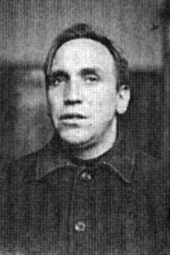Search for Names, Places and Biographies
Already layed Stumbling Stones
Suche
Ehrenfried Diers * 1908
Reeseberg 104 (Harburg, Wilstorf)
HIER WOHNTE
EHRENFRIED DIERS
JG. 1908
EINGEWIESEN 1930
ROTENBURGER ANSTALTEN
`VERLEGT´ 10.10.1941
HEILANSTALT LÜNEBURG
ERMORDET 14.9.1944
Ehrenfried Diers, born on 29 June 1908 in Harburg, committed to the "Rotenburg Institute of the Inner Mission” ("Rotenburger Anstalten der Inneren Mission”) in 1930, "transferred” to the Lüneburg "Provincial Sanatorium and Nursing Home” ("Provinzial-Heil- und Pflegeanstalt” Lüneburg) on 10 Oct. 1941, perished on 14 Sept. 1944
Wilstorf quarter, Reeseberg 104
Ehrenfried Diers grew up in a difficult environment. Six of his siblings died right after their birth. His father, Anton Karl Diers, was an alcoholic and his mother Anna Luise Marie Diers, née Starzonek, was not up to her task in raising the children and housekeeping. In 1926, the parents were deprived of their rights to raise the children because of "bad domestic conditions and unsocial behavior.”
We do not know what happened to Ehrenfried in the meantime, but after he had spent three years in a public educational institution, he was admitted as a young adult on 23 Mar. 1929 to the Langenhagen Provincial Institute because of "imbecility” and on 12 May 1930 to the "Rotenburg Institute of the Inner Mission.”
He seemed to be doing quite well in this environment. He was described as a friendly and calm student who did not cause any difficulties and knew how to occupy himself. He did not want to have anything to do with his parents. He was neither interested in a leave with them in Harburg nor in their visiting him in Rotenburg. When they once invited him home in Oct. 1932, he could not make it through a fortnight with them, and when his mother announced her visit to Rotenburg shortly thereafter, he informed the caregivers that he did not want to see her and that she should take note of that. During the next months, he showed himself to be more obliging and helpful than usual and made every effort to behave in such a way that he was allowed to stay in the institution.
After 1933, Nazi health and population policy also led to far-reaching changes in this Lower Saxony institution. As prescribed in the "Law for the Prevention of Offspring with Hereditary Diseases” ("Gesetz zur Verhütung erbkranken Nachwuchses”), the entire complex was declared a closed "institution.” For the majority of the residents, i.e., all those who were considered "able to reproduce,” this meant that they could no longer be granted leave or discharge. The hospital was also involved in forced sterilizations. At least 238 men and 97 women from the Rotenburg Institute were forcibly sterilized during the Nazi era. Ehrenfried Diers was apparently spared this suffering.
Even more dramatic were the consequences of Adolf Hitler’s authorization to kill the terminally ill. The first Rotenburg patients were already on their way to the gas chambers of the Hadamar "euthanasia” killing center when this phase of the Nazi program entailing destruction of "unworthy life” ("unwertes Leben”) was stopped in Aug. 1941. However, that was not the end of the killing. It is estimated that 87,000 persons with disabilities died afterward due to deliberate deprivation of food, incorrect administration of medication, and failure to provide medical assistance.
In the course of 1941, when the need for additional premises for the accommodation of reserve military hospitals and alternative hospitals increased sharply due to the war, the Rotenburg Institute was also affected by the consequences. Within a few weeks, all buildings had to be vacated and more than 800 residents had to be transported to other facilities. Seventy-two men, women, and children were lucky enough to be able to return to their families, and 240 able-bodied patients remained in Rotenburg because they were urgently needed for important tasks in the reserve military hospital and in the auxiliary hospital.
Between 1940 and 1945, overall 547 residents of the Rotenburg Institute perished in the facilities to which they had been transferred in the course of the evacuation. The fate of another 50 people remains unresolved.
Of the ten children and seven adults who had fallen ill with diphtheria and TB and who were transferred from Rotenburg to the "Provincial Sanatorium and Nursing Home” on 10 Oct. 1941, 15 (all adults and eight children) died in the following weeks and months. Ehrenfried Diers was among them as well. He perished on 14 Sept. 1944 at the age of 36 years, according to a death certificate from congenital "feeblemindedness and suppuration of the left elbow joint.”
Translator: Erwin Fink
Kindly supported by the Hermann Reemtsma Stiftung, Hamburg.
Stand: June 2020
© Klaus Möller
Quellen: Archiv der Rotenburger Werke der Inneren Mission, Akte Nr. 222; Archiv des ev.-luth. Kirchenkreises Hamburg-Ost; Stadtarchiv Lüneburg; Niedersächsisches Landesarchiv HStAH. Hann. 155 Lüneburg Acc. 2004/085 Nr. 1725; Zuflucht unter dem Schatten Deiner Flügel? Die Rotenburger Anstalten der Inneren Mission in den Jahren 1933–1945, Rotenburger Anstalten der Inneren Mission (Hrsg.), Rotenburg 1992; 100 Jahre Niedersächsisches Landeskrankenhaus Lüneburg, Niedersächsisches Landeskrankenhaus Lüneburg (Hrsg.), Lüneburg 2001; Carola Rudnik, Vielfalt achten, Teilhabe stärken. In: Alfred Fleßner, Uta George, Ingo Harms, Rolf Keller (Hrsg.), Forschungen zur Medizin im Nationalsozialismus, Göttingen 2014.


